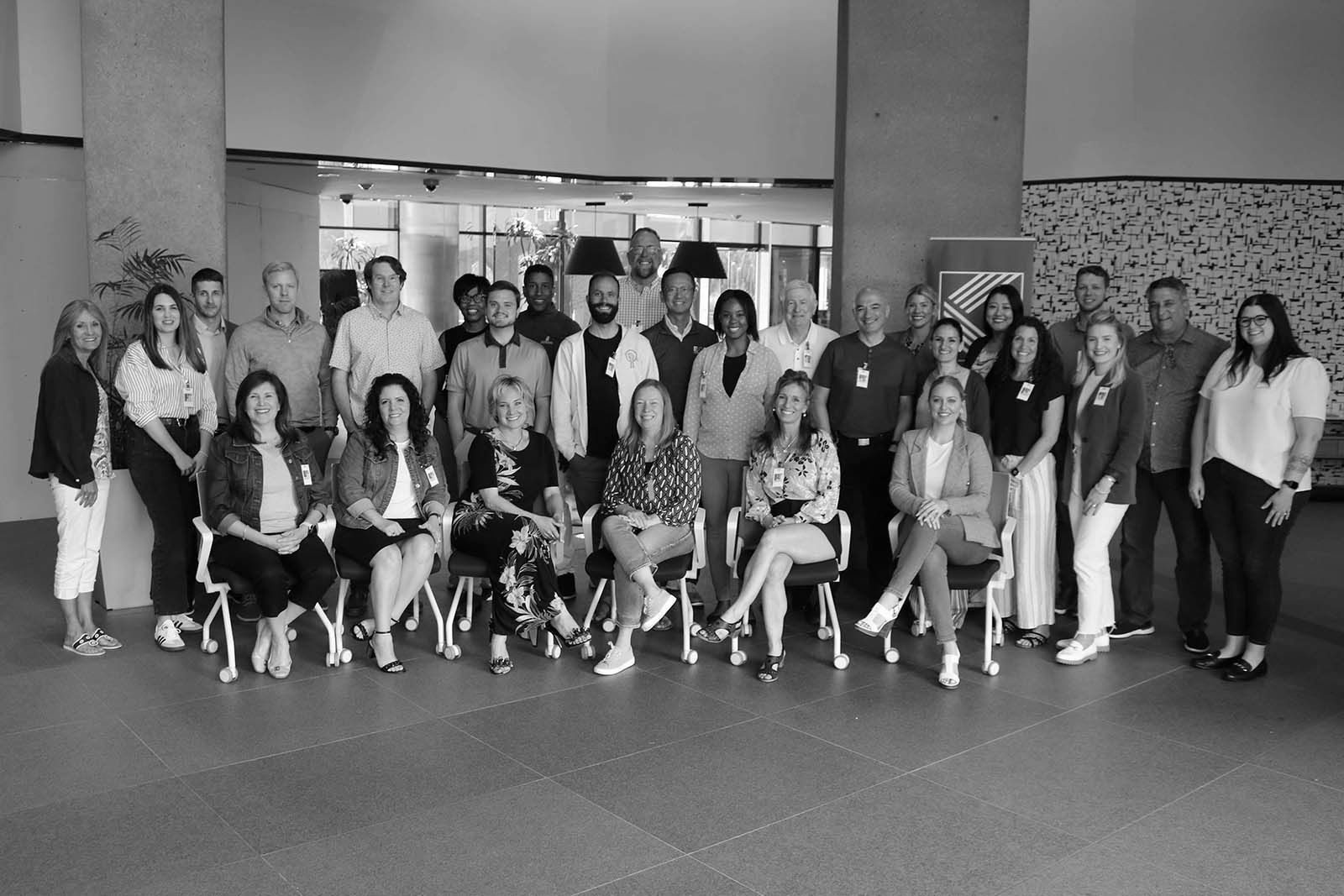Writings, Rumblings + Rants
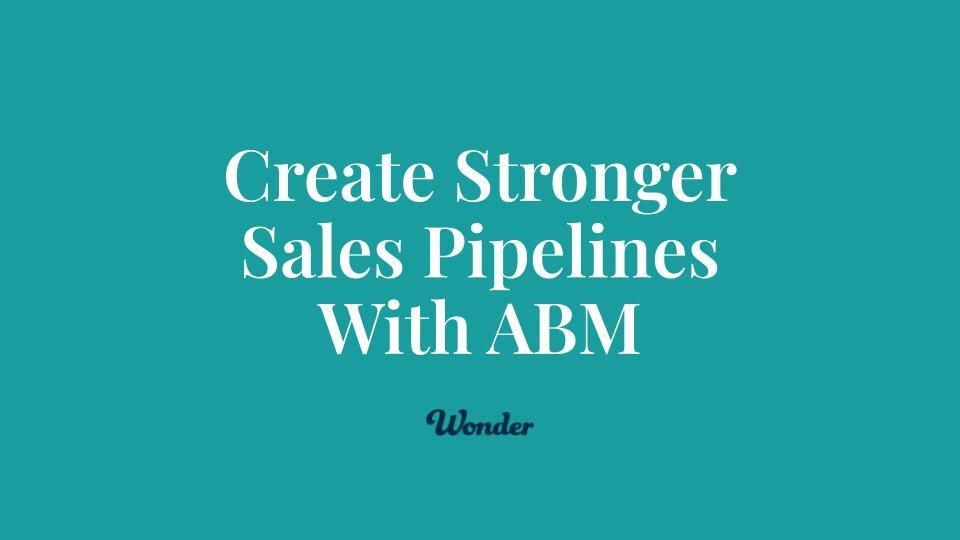
By Mark Henderson
•
March 10, 2025
In B2B sales, the traditional approach has been clear-cut: marketing drives awareness and generates leads, while sales takes those leads and closes deals. But the reality is more complex. Buyers don’t move through a predictable funnel, and purchase decisions aren’t made in isolation. This is where Account-Based Marketing (ABM) changes the game. Rather than focusing on individual leads, ABM aligns sales and marketing around target accounts—companies that fit the ideal customer profile (ICP). It’s a dynamic, data-driven approach that helps teams work together to engage prospects throughout their entire buying journey. Account-Based Marketing (ABM): Not a New Idea, But a Better Execution The concept of ABM has been around for years—previously known as “Key Account Marketing.” What’s different today is the power of digital data and technology. With a combination of first-party and third-party data, advanced targeting, and personalized messaging, ABM enables teams to: Identify the right accounts with precision Engage the full buying team within each organization Deliver the right message at the right time based on where each prospect is in their decision-making process By focusing marketing efforts on accounts that sales has already prioritized, ABM ensures that resources are spent on the highest-value opportunities. Why ABM Works Better for B2B Sales 1. B2B Buying Decisions Are Made by Committees Very few B2B deals are decided by a single person. Instead, purchase decisions often involve 8 to 13 stakeholders across different roles: Initiators - those who start the buying process Researchers - team members gathering vendor options Influencers - stakeholders pushing for features they favor Decision-makers - leaders signing off on the purchase Traditional marketing often targets just one individual, but ABM engages the full buying committee, ensuring the right people receive relevant content and messaging throughout their journey. 2. ABM Uses Data and Technology to Deliver Meaningful Engagement One of ABM’s biggest advantages is its ability to meet buyers where they are—not just with broad awareness campaigns, but with targeted content tailored to their stage in the buying process. Using marketing automation, CRM data, and intent-based signals, ABM delivers messaging that speaks to the unique priorities of each stakeholder—whether they’re just starting research or narrowing down vendors. The result? Higher engagement, shorter sales cycles, and stronger conversion rates. Account-Based Marketing: A Smarter Way to Drive B2B Growth ABM isn’t about generating more leads—it’s about generating the right opportunities. By aligning sales and marketing around a focused list of high-value accounts, engaging full buying teams, and leveraging data-driven insights, ABM helps B2B companies win more deals with the right customers. If you’re ready to refine your sales and marketing strategy with ABM, let’s start the conversation. Let’s talk.
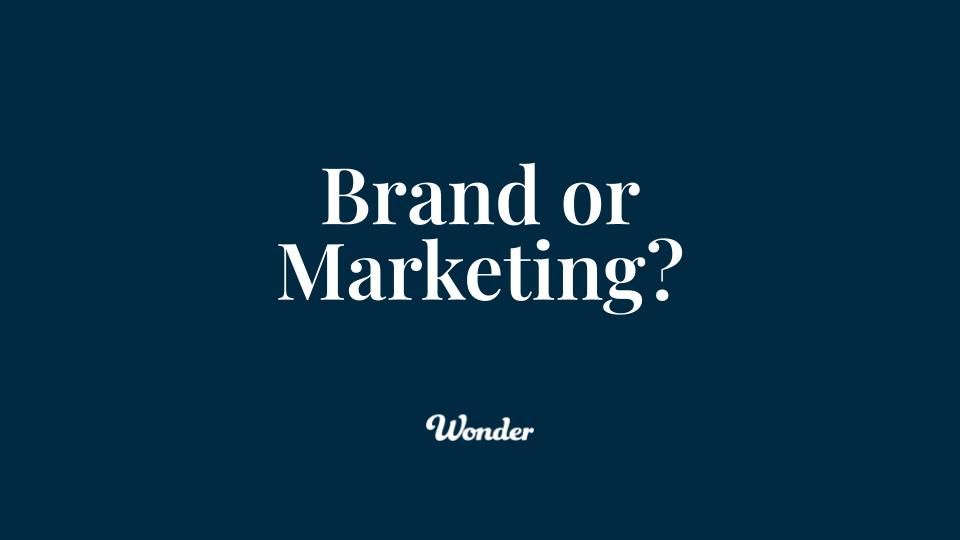
By Jami Mullikin
•
February 13, 2025
Are we a brand agency or a marketing agency? At Wonder, we’re a strategy, marketing, and media firm that helps visionary B2B brands grow. We break down the key differences between brand strategy and marketing execution, explain our Next 90™ Marketing Operating System, and share what to look for when hiring a brand agency. Plus, take our free Brand Health Assessment to see if your brand needs a strategic refresh.

By Jami Mullikin
•
February 10, 2025
Strong brands start from the inside out, ensuring clarity, trust, and long-term value. Our Brand Health Assessment helps measure internal alignment across leadership, messaging, perception, and consistency. Take the free assessment to uncover strengths, identify gaps, and track your brand’s health over time.
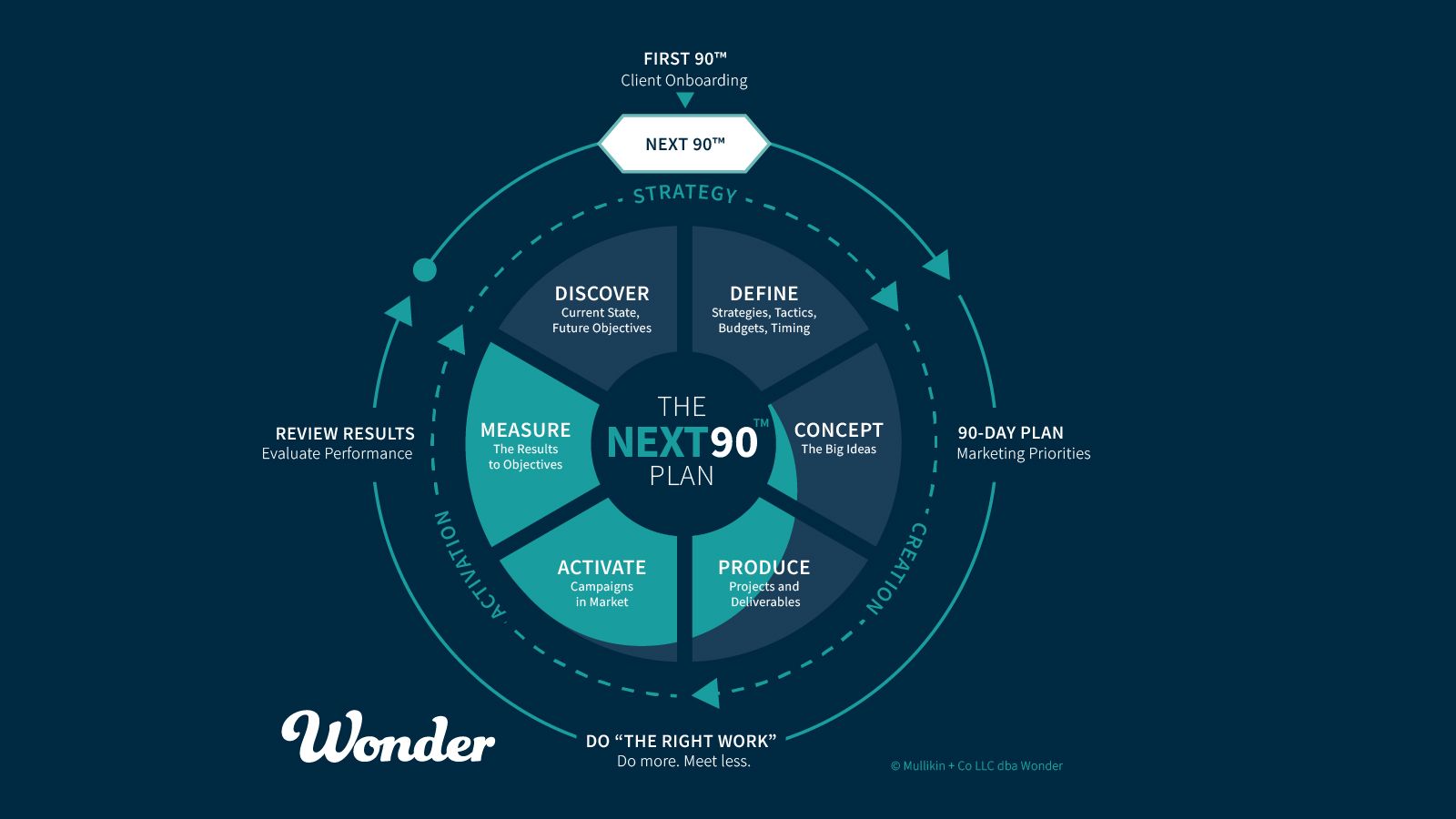
By Jami Mullikin
•
February 2, 2025
In most organizations, marketing teams are expected to do a lot with very little. They’re often under-resourced, understaffed, and stretched thin. In these situations, every person, every penny, and every strategic priority must be planned wisely. But how do we ensure that the work we’re doing today builds momentum for desired results 18-36 months from now? At Wonder, we believe that brands are built from the inside out. If we want to market effectively tomorrow, we must first have absolute clarity on who we are today. Building from the Core The foundation of any strong brand starts with Core Values. These values define who we are, how we operate, and what we stand for. Once we’re clear on that, we can establish our Core Focus—a concept from EOS® (Entrepreneurial Operating System®) that helps businesses define their niche and target market. With our values, purpose, and vision in place, we can build out the critical elements of our brand: Brand Pillars – What makes us different and why our audience should care. Brand Personality – How we communicate and our voice and tone. Brand Promise – The commitment of value we make to our customers. This foundation is what we call the Brand Platform, and it gives us the clarity we need to move forward strategically. Marketing with a Clear Vision Once we’ve established our brand foundation, we can start looking ahead: 5-10 Year Vision – Where is the organization (brand) headed long-term? 3-Year Picture – What does success look like in the mid-term? 1-Year Marketing Activation Plan – A focused, strategic approach to marketing for the next 12 months. The Marketing Activation Plan is where strategy meets execution. It aligns 4-6 key objectives with 4-6 strategic initiatives, ensuring that marketing is leveraging its resources—time, talent, and budget—in the smartest way possible. This plan is structured over 12 months with clear quarterly priorities, keeping the team focused and accountable. The Next 90™ Marketing Operating System: A Smarter, Healthier Way to Market for the Short and Longterm Marketing isn’t about one-off campaigns or disconnected initiatives. It’s about continuous, focused action. That’s why we built the Next 90™ marketing operating system. Our process starts with the First 90™, where we onboard clients by balancing immediate marketing activities with long-term strategic planning. At the end of this phase, our clients receive a One-Year Marketing Activation Plan and a set of Next 90™ priorities—a clear roadmap of projects and initiatives to drive growth one quarter at-a-time. By aligning marketing with long-term vision and mid-term sales objectives, we ensure that every move we make today builds the future we want tomorrow. The result? Smart, strategic marketing that makes a lasting impact—with sales and marketing working together toward the same end goal. Want to learn how the Next 90™ can help your business? Let’s talk.
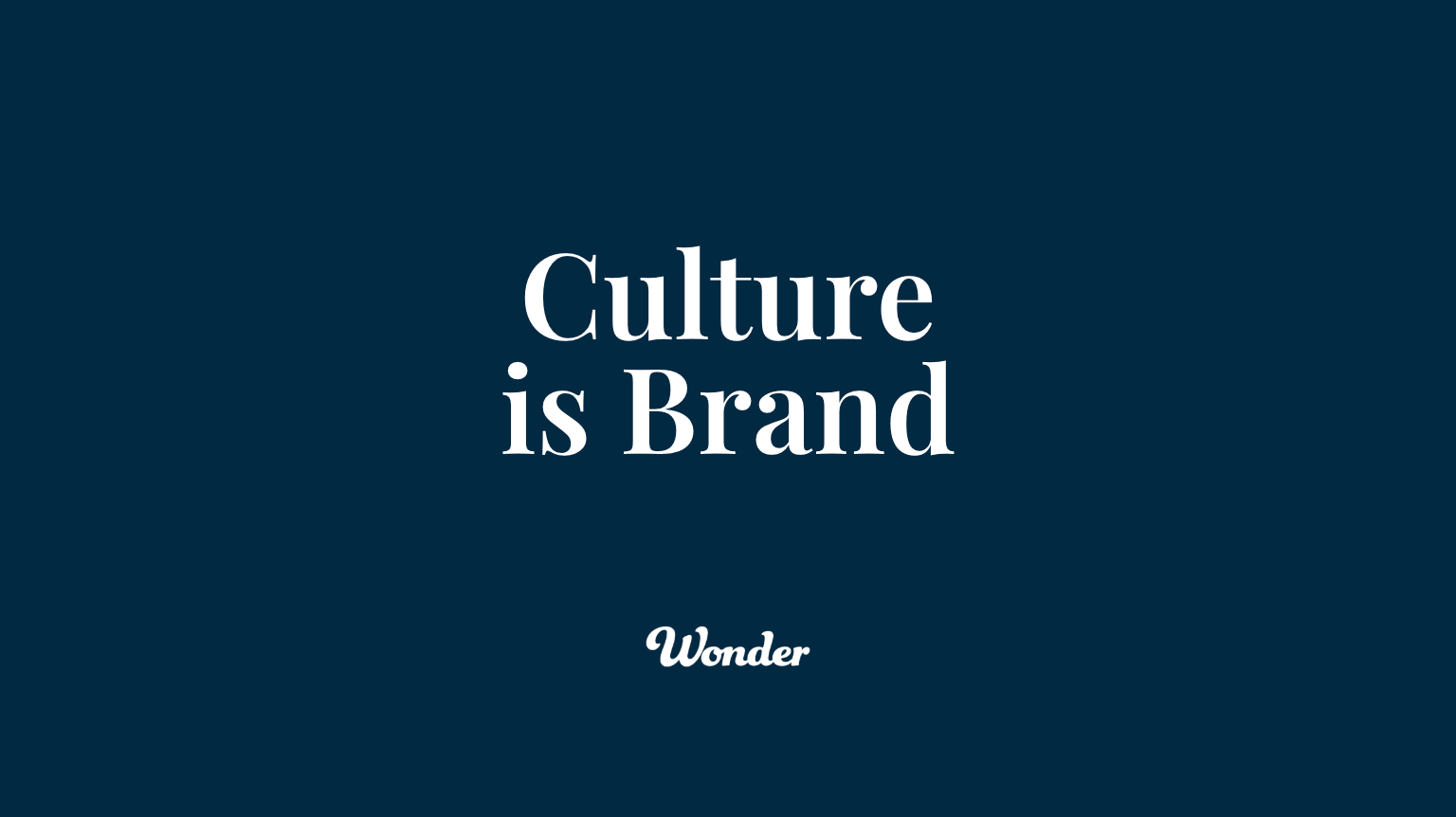
By Jami Mullikin
•
January 11, 2025
Changing an organization’s culture is no small task. It requires commitment, clarity, and visible proof of change. Whether you’re looking to turn around a struggling business or simply realign your team with a stronger sense of purpose, two key levers— rebranding and leadership change —can catalyze meaningful cultural transformation. For organizations running on EOS®, culture change aligns with the foundational values of Vision , Traction , and Healthy . Vision provides clarity on where you’re going and why it matters, Traction ensures you take consistent action to move forward, and Healthy focuses on building a cohesive team and culture. Together, these values set the stage for a thriving organization. Here’s how rebranding and leadership change can help reshape your culture while staying aligned with these EOS principles. Rebrand: A Visible Recommitment to Values A rebrand isn’t just a new logo or website—it’s a visible recommitment to your values. It’s a statement to employees, customers, and stakeholders that the organization is evolving, and it provides clear evidence of that change. But here’s the key: a rebrand must be authentic. If it’s simply a cosmetic update with no deeper alignment to the organization’s values, it will fall flat. Successful rebrands are built from the inside out, starting with a reassessment of your purpose, core values, and vision. At its best, a rebrand embodies the EOS concept of Vision : aligning everyone in your organization around a shared understanding of where you’re going and how you’ll get there. A rebrand signals: A recommitment to what matters most to your organization. Alignment between your internal culture and external messaging. A clear direction for where you’re headed and why it matters. Remember, marketing is an activity, but brand is an interaction. While marketing messages can evolve with trends and market demands, your brand is grounded in the values and culture that define your organization. An effective brand strategy should provide 10+ years of runway toward a clearly defined vision, ensuring consistency and building trust over time. Leadership Change: Leadership Committed to Change In any organization, culture starts at the top. When a new leader steps in—whether it’s a Visionary or Integrator in an EOS® company or a new President or CEO in a non-EOS organization—it represents a tangible commitment to change. A leadership change is one of the most visible signals that an organization is serious about transforming its culture. But for it to work, the new leader must embody the values and vision that the organization is striving for. Their actions, decisions, and communication style set the tone for the rest of the team. Here’s why leadership change works: It resets expectations. A new leader often brings a fresh perspective and an opportunity to realign the team. It inspires confidence. Employees, customers, and stakeholders see visible proof that the organization is committed to improvement. It reinforces accountability. New leadership often comes with new goals, priorities, and a recommitment to delivering on the organization’s promises. Leadership changes are deeply tied to the EOS value of Traction , as they create momentum and accountability for executing on your vision. By ensuring the new leader is aligned with your values and vision, you can build a stronger, more cohesive culture. Values-Driven Culture: The Key to a Healthy Organization At the heart of both rebranding and leadership change is a commitment to values. In EOS, Healthy is about fostering a culture of trust, transparency, and collaboration. A healthy culture ensures that your team isn’t just aligned on goals—they’re engaged and thriving as they work toward them. While marketing value propositions may ebb and flow with the market, your brand should be driven by values that rarely change. These values provide the compass for decision-making, hiring, and customer engagement, ensuring that your culture evolves in a way that stays true to who you are. When combined with a clear vision and effective brand strategy, this values-driven approach gives your organization the consistency and clarity needed to thrive to achieve even bigger, hairier, audacious goals. Does Your Culture Need to Change? If your culture needs a shift, maybe it’s time to consider a rebrand. At Wonder, we specialize in helping organizations activate their brand from the inside out—connecting their purpose, values, and vision to their culture and customer experience.
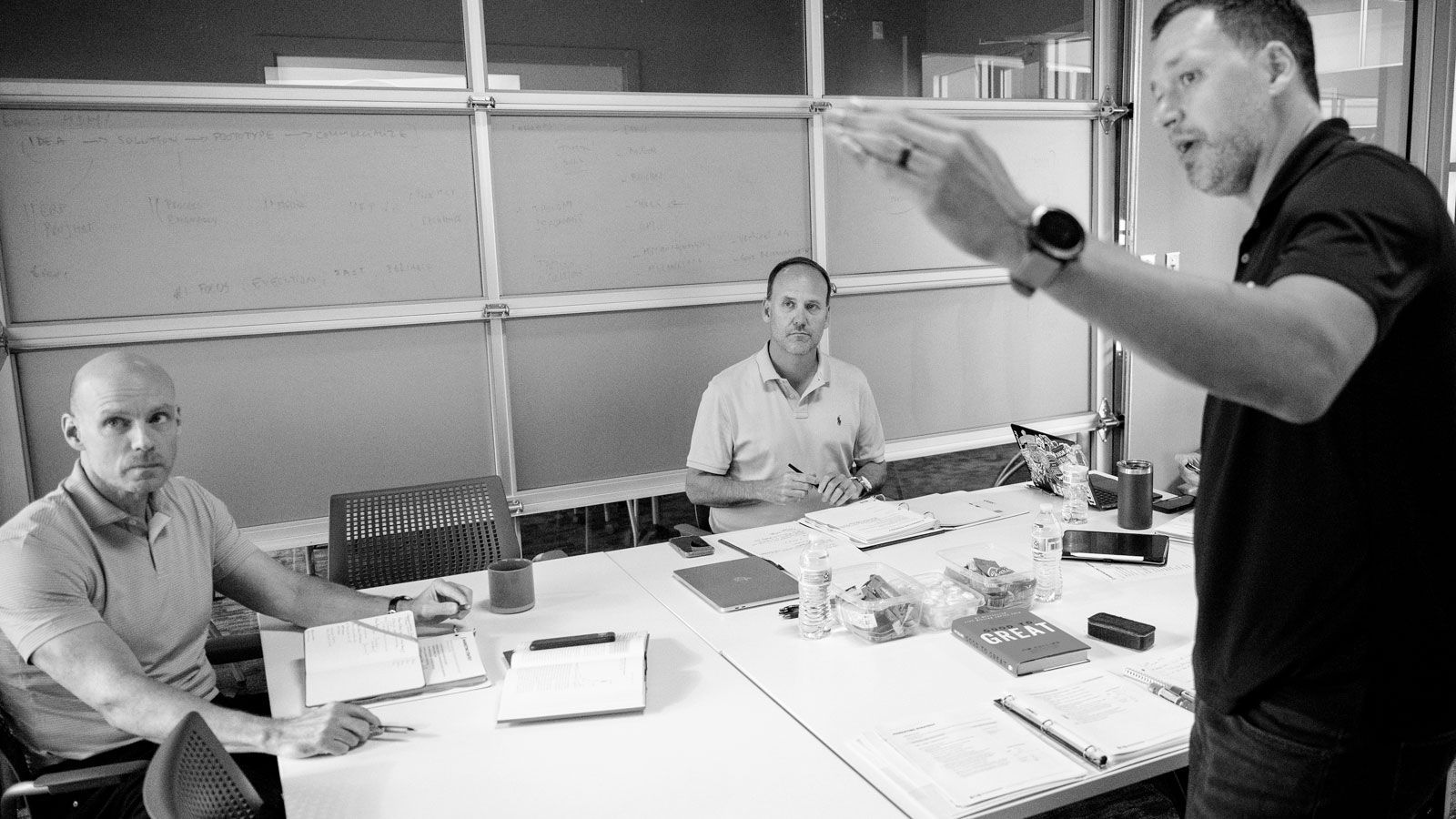
By Jami Mullikin
•
January 9, 2025
Core values are not just words on a wall—they’re the foundation of your organization’s identity, culture, and brand. When crafted thoughtfully, they guide decision-making, shape company culture, and attract the right people to the right seats on your team. But creating authentic core values that truly resonate with your team and brand takes intention, collaboration, and time.
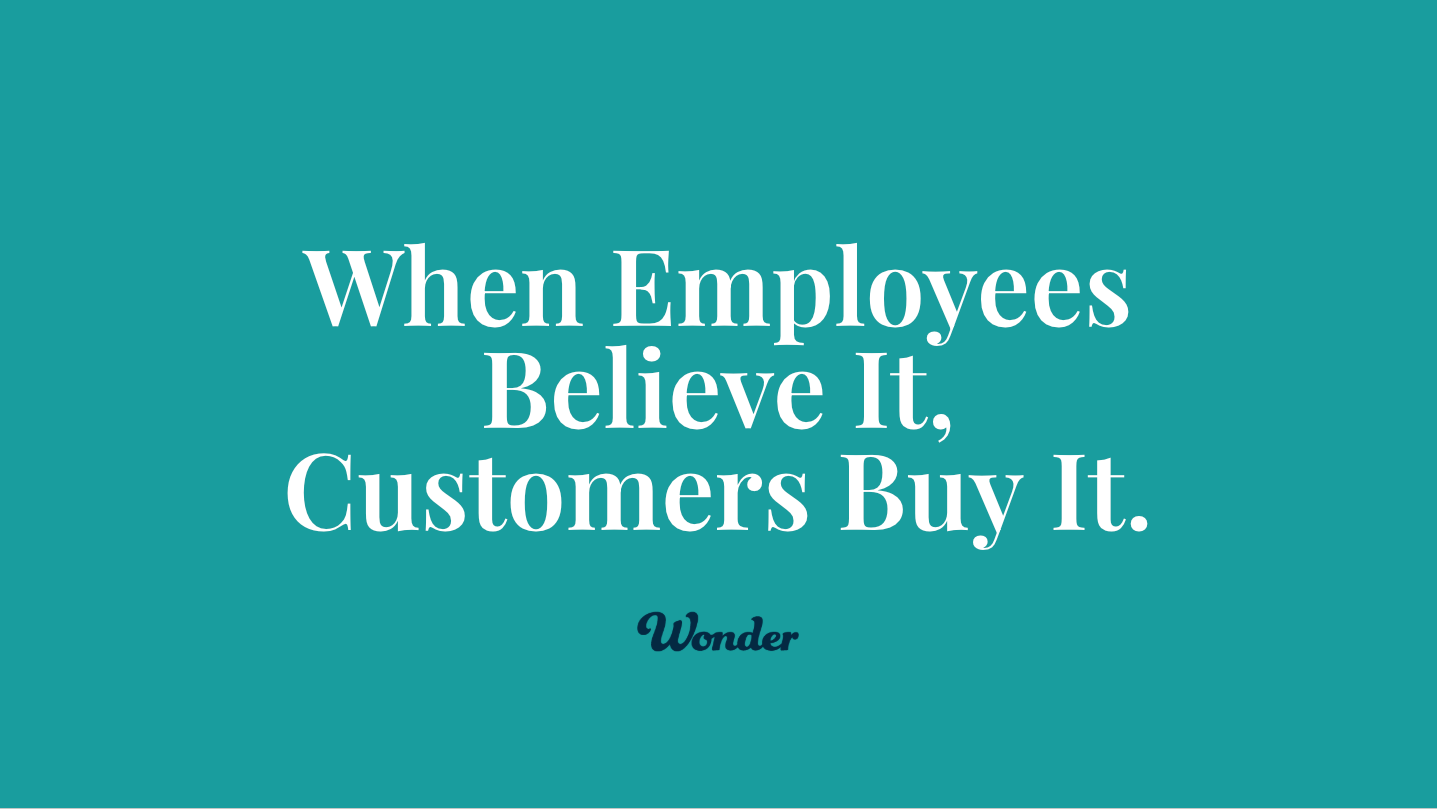
By Jami Mullikin
•
January 7, 2025
The best Visionary Brands are built from the inside out, starting with a strong foundation. EOS® (Entrepreneurial Operating System®) provides the perfect framework for laying that foundation through the Vision/Traction Organizer™ (V/TO™). By clarifying your purpose, core values, vision, and goals, you can align your team around a shared mission and create a brand that delivers far beyond marketing.
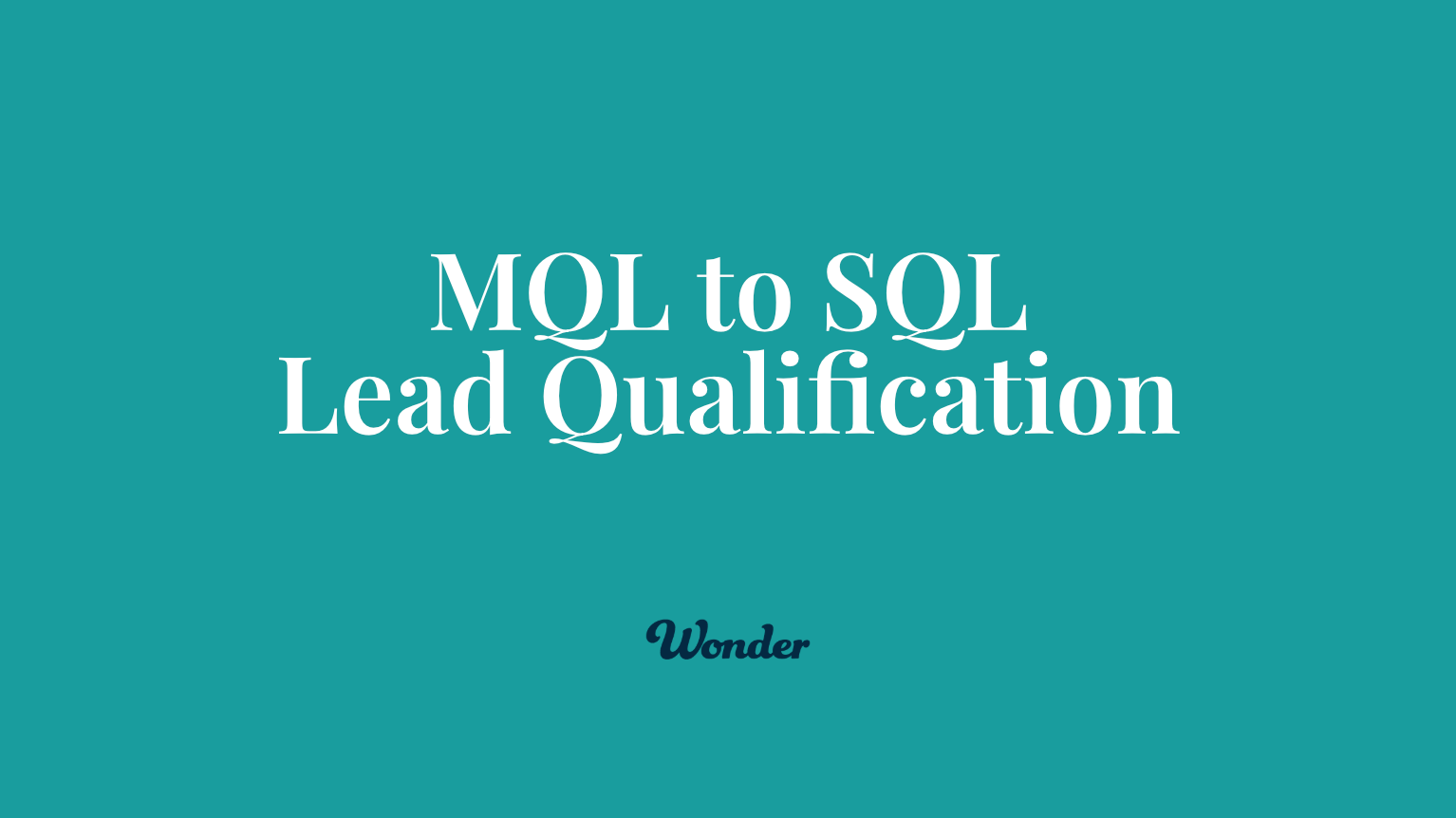
By Jami Mullikin
•
January 2, 2025
Marketing and sales alignment is one of the biggest challenges for many businesses, yet it’s also one of the most critical components for success. A key step in bridging this gap is clearly defining what makes a lead Marketing Qualified (MQL) and ensuring it meets the criteria sales is willing to accept. When marketing and sales operate in harmony, using shared definitions and processes, leads flow through the funnel more effectively—and revenue growth from marketing investments follow.

By Jami Mullikin
•
December 18, 2024
When running a business on the Entrepreneurial Operating System® (EOS®), clarity and structure drive results. Two powerful tools within EOS—the Core Processes and the Proven Process—serve distinct, yet complementary purposes in your business. Both are essential to achieving Vision and Traction, yet they operate in different arenas with unique objectives. In my EOS experience, understanding their roles is a vital early step in your EOS journey. The Core Processes: Simplifying Your Internal Operations The Core Processes are the backbone of your organization’s internal efficiency. They represent the 20% of activities that drive 80% of your desired outcomes. These processes should occur explicitly and consistently 100% of the time, ensuring that the core operations of your business are streamlined and effective. Imagine you sell a product. Once the sale is closed, the natural progression leads to billing the client. What happens in between? The Core Processes systematize and document those steps, leaving no room for ambiguity. They help you answer, “How do we do this every single time to get the best results?” At Wonder, for instance, one of our Core Processes is what happens after a client agrees to work with us. We call it Onboarding. We’ve outlined a clear, repeatable set of steps that ensures every project starts on the right foot and delivers the best outcomes. Here’s a simplified example: Intro/Brief Call Billing Worksheet Initiate Billing Client Assets/Tech Job Brief

By Jami Mullikin
•
November 22, 2024
In the fast-paced world of technology sales, Value-Added Resellers (VARs), Managed Service Providers (MSPs), and System Integrators face a common challenge: differentiation. The industry is crowded, and many players rely heavily on vendor-provided Marketing Development Funds (MDF) to shape their marketing and branding efforts. While vendor support can be helpful, it often results in a uniform voice that makes it hard to stand out.
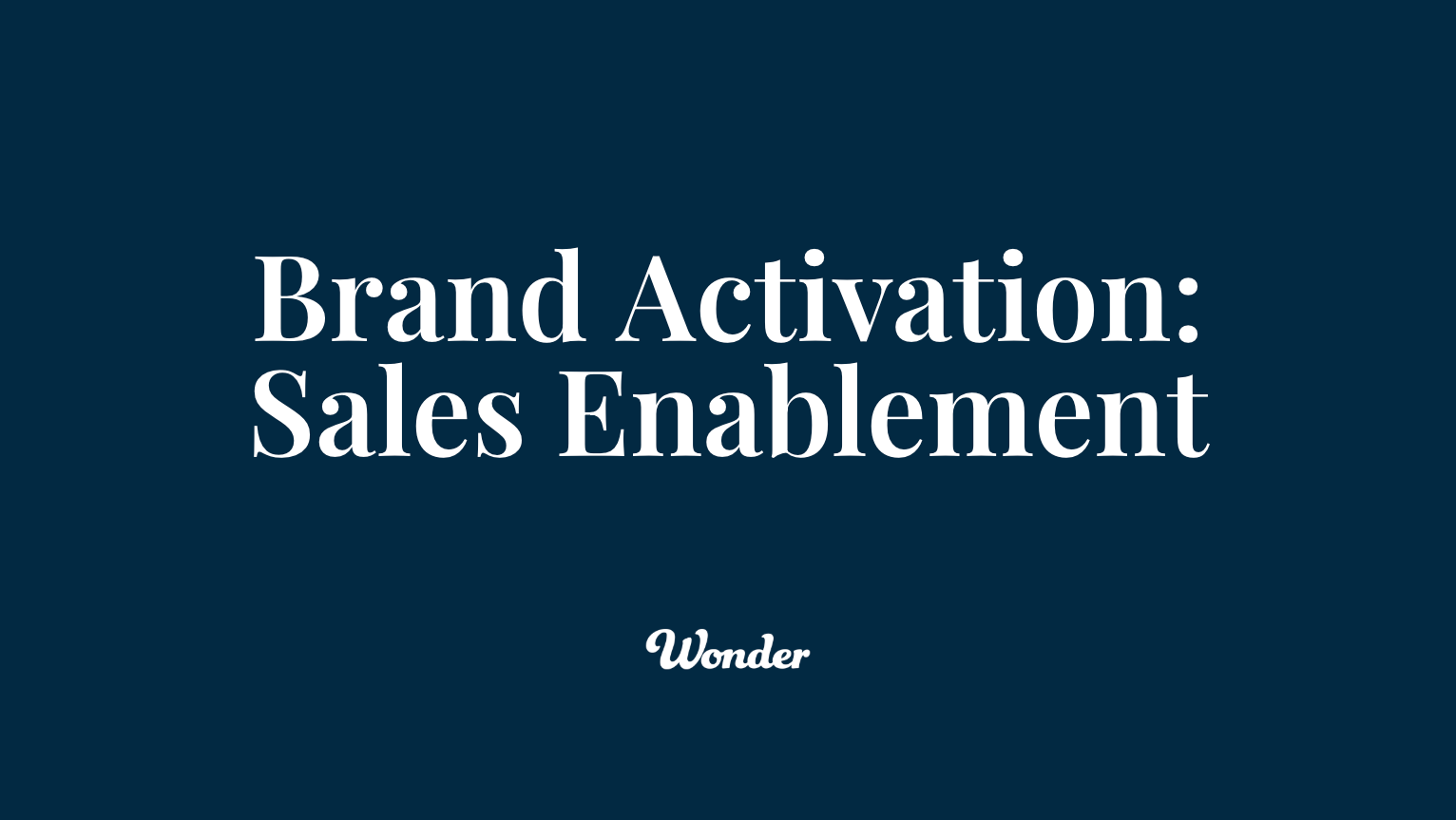
By Jami Mullikin
•
October 29, 2024
Activating your brand externally is a powerful way to drive growth, create loyalty, and amplify your impact. But where do you start? While many focus first on top-of-funnel activities like advertising or social media, we believe the most effective way to begin external activation is at the bottom of the funnel—with sales enablement . Why? Because sales is where your brand promise becomes tangible. It’s the moment your prospects decide whether or not to trust you with their business. Starting with sales enablement ensures your messaging is clear, consistent, and aligned with your brand at the most critical point in the customer journey. Here’s why sales enablement should be the foundation of your external brand activation—and how to do it effectively. Why Start with Sales Enablement? The Bottom of the Funnel is Where Decisions Happen At the bottom of the funnel, prospects are no longer browsing—they’re deciding. This is where the rubber meets the road, and your brand has to deliver. By starting here, you ensure that your team is equipped to close deals and generate revenue quicker. Sales Interactions Define Your Brand Your sales team isn’t just selling a product or service—they’re representing your brand. Every conversation, presentation, and follow-up email shapes how prospects perceive your company. Without consistent, compelling messaging, even the best brand strategy can fall flat. Improves ROI Across the Funnel Sales enablement doesn’t just help close deals—it makes your entire funnel more effective. When your sales team is armed with the right tools and messaging, they convert more leads into customers, maximizing the ROI of your marketing efforts. Drives Alignment Between Marketing and Sales Starting with sales enablement forces alignment between marketing and sales teams. It ensures both teams are speaking the same language and working toward shared goals, creating a seamless experience for prospects. What Great Sales Enablement Looks Like Sales enablement is about giving your team the tools, resources, and support they need to sell effectively while staying true to your brand. Here’s how we approach it: Develop a Unified Brand Story Your sales team needs a clear, compelling story that aligns with your brand and resonates with your target audience. This includes: An understanding of your Brand Platform Strong value propositions for each target market. Messaging that highlights the customer’s pain points and how your solution solves them. Stories or case studies that bring your brand to life. Deliver a Pitch Book The first and most critical sales enablement tool is your Pitch Book : the 8–12 most important slides that train your sales team and serve as the foundation for presentations to prospects and customers. A well-crafted Pitch Book ensures that every member of your sales team delivers a consistent, powerful message that aligns with your brand. It typically includes: The problem you solve and why it matters. Your unique brand pillars and promise. Key differentiators and proof points. Client success stories and case studies. Create Sales Tools That Work Equip your team with additional resources that make it easy to sell, such as: Branded pitch decks and proposals. Product one-pagers and FAQs. Interactive tools like ROI calculators or product demos. Train Your Sales Team Even the best tools won’t make an impact without proper training. Your sales team needs to understand how to use the tools, deliver the messaging, and handle objections—all while staying on-brand. The Ripple Effect: How Sales Enablement Fuels Broader Activation Starting with sales enablement doesn’t mean ignoring other parts of the funnel—it means building a strong foundation that supports everything else. Here’s how it fuels broader brand activation: Middle of the Funnel : Once your sales team is aligned with your brand, it’s easier to create effective nurture campaigns that guide leads toward a purchase. Top of the Funnel : Sales enablement provides the insights you need to create marketing campaigns that attract the right audience and drive qualified leads. Customer Experience : A consistent brand experience during the sales process sets the tone for long-term customer relationships. Wonder’s Approach to Brand Activation At Wonder, we believe external brand activation should always start with the people who represent your brand most directly: your sales team. By aligning your messaging, tools, and training, we help you create a seamless, on-brand experience that converts prospects into customers and builds trust at every interaction. From there, we scale your activation efforts to the middle and top of the funnel, creating campaigns and assets that amplify your brand and attract the right audience. This inside-out approach ensures your brand remains authentic, consistent, and impactful across every stage of the customer journey.

By Jami Mullikin
•
September 1, 2024
An Introduction to Kolbe Wisdom™ for Leadership, Team and Personal Development In the ever-evolving landscape of career development and team dynamics, various assessment tools have emerged, each offering unique insights into personal and professional aptitudes. Among them, the Kolbe A Index stands out as our recommended tool for helping individuals discover work they love. As a certified Kolbe Consultant with over four years of experience using the Kolbe Index, I've gained deep insights into its effectiveness and how it complements other popular assessments like the Predictive Index™, Myers-Briggs Type Indicator®, CliftonStrengths, and DiSC. Understanding the Kolbe A Index The Kolbe A Index differs fundamentally from other assessments by focusing on the "conative" part of the mind, which governs how a person takes action or reacts when striving - or when applying effort. Unlike the affective domain of personality tests (encompassing feelings, desires, and attitudes), which is the focus of tools like DISC, Myers-Briggs or the Predictive Index, the Kolbe A Index taps into innate instincts that are stable over time. This makes it an incredibly reliable tool, with a proven reliability of a 90% retake rate, in contrast to the around 44% test-retest reliability of some affective domain tools. Four Primary Zones of the Kolbe A Index Information: How a person gathers and shares information. Organization : The natural method of organizing tasks and projects. Change : The individual's instinctive approach to change and risk. Physical Space: How one interacts with and manages their physical environment. Complementing Other Assessments While the Kolbe A Index focuses on the conative, doing domain, other assessments measure traits within the affective domain. This distinction is crucial, as it means these tools are not redundant but rather complementary. For example: The Predictive Index and Myers-Briggs can shed light on a person’s desires, values, and personality, offering insights into what a person wants or wishes would happen. The Kolbe A Index, on the other hand, reveals how a person will naturally act and react, highlighting innate methods of problem-solving and action-taking. Practical Application of Kolbe with Teams In team settings, combining the insights from both conative and affective assessments can be transformative. The Kolbe A Index's WAREwithal® software predicts how people will naturally work together and the potential roadblocks in collaboration. It focuses on how individuals will act, react, and interact, while tools like the Predictive Index can explain interpersonal dynamics, like why people like or dislike each other. Assessing Tension in a Current Job with Kolbe B A significant advantage of the Kolbe B Index is its ability to identify sources of tension in one's current job. This tension often arises from a misalignment between an individual's natural instincts and the demands or expectations of their role. The Kolbe B Index can pinpoint where this discord occurs across the four primary zones (Information, Organization, Change, Physical Space), helping individuals and their managers understand potential areas of stress or dissatisfaction. For instance, an individual with a strong instinct for detailed information gathering may feel overwhelmed in a role that requires quick, high-level decision-making. Similarly, a person with a natural tendency towards maintaining structured organization might struggle in a dynamic environment that demands constant adaptation. By identifying these areas of tension, the Kolbe B Index enables individuals and their employers to make informed adjustments. This could involve tweaking job responsibilities, providing additional support or training, or even reevaluating the role to better align with an employee's conative strengths. Such insights can lead to increased job satisfaction, reduced stress, and higher productivity. Increasing Hiring Success with Kolbe C The Kolbe C Index plays a crucial role in defining the right strengths for a role and increasing hiring success. Unlike the Kolbe A Index, which assesses an individual's natural instincts, the Kolbe C Index measures the attributes and behaviors a manager believes are required for success in a specific job. This assessment helps in creating a job profile that aligns with the company’s goals and the specific demands of the role. When the results of Kolbe C are compared with a candidate's Kolbe A results, it provides a clear picture of how well the candidate's instinctive methods of operation align with the job requirements - Kolbe calls this the Range of Success. This alignment is critical for ensuring long-term job satisfaction and effectiveness. For example, if a role requires a high degree of innovation and adaptability, but a candidate's Kolbe A results indicate a preference for routine and structure, there may be a misalignment that could lead to challenges down the line. Conversely, a strong alignment between a candidate's natural strengths (as identified by Kolbe A) and the role's requirements (as outlined by Kolbe C) suggests a higher likelihood of success and job satisfaction. By leveraging both Kolbe A and C indices, organizations can make more informed hiring decisions. This approach not only increases the probability of hiring candidates who are naturally inclined to excel in their roles but also promotes a workplace environment where employees' natural strengths are recognized and utilized effectively. Leveraging Kolbe RightFit™ Hiring Incorporating the Kolbe A and C Indices into the hiring process and ongoing job performance assessments can significantly impact workplace dynamics. The Kolbe RightFit™ hiring software provides a comprehensive understanding of both an individual's innate strengths and the specific demands of a job. By aligning these two aspects, organizations can foster a more harmonious, productive, and satisfying work environment, leading to greater success for both employees and the company as a whole. Kolbe is Your Retention Strategy The Kolbe Index, particularly in its A and C variants, serves as a pivotal anchor for both professional and personal development within an organization. By offering deep insights into an individual's instinctive action modes (Kolbe A) and aligning them with the specific requirements of a role (Kolbe C), it creates a powerful framework for growth and fulfillment. This alignment not only enhances job satisfaction and performance but also fosters a culture where personal strengths are recognized and valued. As employees become more engaged and their natural talents are leveraged effectively, the organization as a whole benefits from increased innovation, efficiency, and team harmony. Thus, the Kolbe Index not only guides individual development but also shapes the organizational ethos, making it a vital tool in nurturing a thriving and dynamic workplace. Kolbe Certified Consultants™ At Wonder, we chose the Kolbe A Index™ is our primary retention strategy to help ourselves and our clients hire great talent, enhance career development and optimize team performance. Its unique focus on innate instincts, combined with its high reliability, makes it an invaluable resource for understanding natural instincts in the dynamic agency workplace. When used alongside other assessments, it provides a comprehensive view of an individual's professional and interpersonal aptitudes, paving the way for more effective team collaboration and personal career satisfaction. Working with a Kolbe Consultant offers distinct benefits for both job seekers and employers, streamlining the process of finding the right fit for each role and enhancing workplace dynamics. Kolbe for Job Seekers: Self-Awareness : A Kolbe Consultant helps job seekers understand their instinctive strengths and work styles through the Kolbe A Index. This self-awareness is crucial in identifying roles and careers where they are most likely to excel and be satisfied. Career Alignment : Consultants guide individuals in aligning their natural talents with potential job opportunities, ensuring a more fulfilling and sustainable career path. Personalized Advice : Job seekers receive tailored advice on how to present their strengths in resumes and interviews, helping them stand out in the job market. Kolbe for Employers: Improved Hiring Accuracy : By using the Kolbe C Index, a Kolbe Consultant assists employers in defining the conative requirements of a job, leading to more effective and accurate hiring decisions. Enhanced Team Dynamics: Consultants help in understanding the diverse instinctive strengths of team members, fostering better collaboration, conflict resolution, and productivity. Employee Retention: By aligning employees' natural strengths with their roles, employers can significantly improve job satisfaction and retention, reducing turnover costs. In summary, a Kolbe Consultant acts as a bridge between job seekers' innate strengths and employers' needs, leading to more harmonious, effective, and satisfying workplace environments. If you're interested in learning more about Kolbe, please reach out and let us know . We'd love to help. You can also order your Kolbe Assessment directly on our Kolbe Store .

By Jami Mullikin
•
August 12, 2024
Sometimes qualifying your prospects who are interested in paid search or SEO services can be heard. To make it more relatable, let's use an analogy: think of paid search as buying apples and organic search, or SEO, as planting an apple orchard. If a clients need results today, they may be best served with paid search - or buying apples today at retail prices. If they're looking further out, and desire a longer-term competitive advantage and can postpone the immediate ROI, then organic search, or search engine optimization, may be a better bet - it's more like growing apples. Should we recommend Paid Search or SEO? Buying Apples Today: Paid Search When a prospect or client expresses interest in paid search, it's like they need apples today. They want immediate results, and they're willing to pay for it. Here are the key reasons why this might be the best option for them: I nstant Visibility: Just like finding apples in the store, paid search gives businesses immediate visibility on search engine result pages. Targeted Traffic: With paid search, businesses can target their ads towards a specific audience based on factors like location, demographics, and even the time of day. Control Over Budget and Bidding: Paid search allows businesses to control how much they spend. They can set a budget cap to ensure they don't overspend and can adjust their bidding strategy based on the performance of their ads. Tracking and Measurability: Paid search campaigns are highly measurable. Businesses can track the number of clicks, conversions, and the return on investment (ROI) with precision. Boost Short-Term Sales: If a business has a seasonal product or a time-sensitive offer, paid search is an excellent way to drive short-term sales. Increased Brand Awareness: Although the short-term ROI can measured quickly, paid search also provide potentially millions of brand impressions that in essence has no cost at all. Planting an Apple Tree for Tomorrow: Search Engine Optimization On the other hand, when a prospect is interested in their Google rankings, they're thinking long-term. They want to plant an apple tree today, knowing it will yield a steady supply of apples in the future. Here are some reasons why SEO could be their best bet: Sustainable Visibility: Once a website ranks high in organic search results, it tends to stay there for a while. This leads to sustained visibility without the ongoing cost of paid media or paid search campaigns. Builds Trust and Credibility: Users tend to trust organic search results more than paid ads. Ranking high in organic search signals to users that your site is a credible source of information. Cost-Effective in the Long Run: While SEO requires an upfront investment, it’s often more cost-effective over the long haul. Unlike paid search, organic traffic from search rankings are free, so your cost per acquisition decreases over time. Improved User Experience: A well-optimized website is not just search-engine friendly but user-friendly too. Good SEO practices improve site speed, usability, and mobile-friendliness. Long-Term Growth: SEO, like planting an orchard full of trees, is a long-term investment. It might take some time to see results, but once it starts bearing fruit, it provides a steady flow of organic traffic and leads. Buying Apples Today and Planting an Orchard for Tomorrow: A Combined Approach In some cases, your clients might benefit most from a combined approach — buying apples today (paid search) while planting an apple orchard for tomorrow (SEO). This strategy provides the instant results of paid search with the sustainable, long-term benefits of SEO. Here are some reasons why this approach could be their best bet: Balancing Short and Long-Term Goals: By using both strategies, businesses can meet their immediate sales targets while also laying the groundwork for future, organic growth. Insights and Data: Running paid campaigns can provide valuable data and insights that can be used to inform and optimize the SEO strategy. You get to know which keywords are performing well, what language resonates with your audience, and which demographics are more likely to convert. Visibility Boost: Combining SEO with paid search can enhance a brand's visibility on the search engine results page, increasing the likelihood of click-throughs. Your brand appears both in the paid ad section and in the organic results, which can boost your credibility and reach. Mitigate SEO Volatility: Search engine algorithms change frequently, which can impact your organic rankings. Paid search ads can help to maintain your visibility and traffic during these periods of SEO volatility. Holistic Strategy: A combined approach ensures you have a more holistic digital marketing strategy. You’re not putting all your eggs in one basket, but leveraging the strengths of both paid search and SEO. So, How About Those Apples? In the world of digital marketing, understanding whether your prospects are looking to 'buy apples today' or 'plant an orchard for tomorrow' is crucial to guiding them to the right solution. Both paid search and SEO have their strengths and are suitable for different situations. It's all about identifying the needs of your prospects and aligning them with the right approach to meet their objectives. As an agency partner, your job is to help them understand which option is best for their unique situation and make sound recommendations to help them reach their goals.

By Jami Mullikin
•
July 15, 2024
Greenville, SC - July 1, 2024 – Greenville’s marketing landscape is set to transform with the arrival of Wonder, a one-of-a-kind agency dedicated exclusively to organizations utilizing the Entrepreneurial Operating System (EOS®). Unlike traditional agencies, Wonder specializes in activating brands from the inside out, ensuring that every strategic move aligns with the core tenants of EOS®. Located in the innovative Flywheel co-work space at 25 Goldsmith St, Greenville, SC 29609, Wonder is poised to redefine how businesses in Greenville and beyond approach marketing and brand development. Founded by Jami Mullikin, a seasoned expert with extensive experience building internal brand culture within companies such as ScanSource, KeyMark and Up&Up, Wonder is set to lead growth-oriented clients to extraordinary marketing success. Mullikin is joined by a team of industry veterans, including Warren Griffith, vice president of operations and EOS Integrator; Mark Henderson of Charlotte, NC, vice president of media. Each leader brings over 25 years of experience in their respective fields and shares a passion for driving marketing excellence. " Your employees have to believe it for your customers to buy it, " says Mullikin, emphasizing the agency’s philosophy on a brand’s core messaging. " Living in a 90-day world means staying focused yet agile, ensuring your employees are constantly aligned with your brand's core messaging. At Wonder, we believe that this alignment is crucial for customers to truly buy into your brand. " Wonder's tagline, "Activating Visionary Brands," encapsulates its mission to harmonize internal culture with external market perceptions, driving long-term brand value with clarity and consistency. Wonder offers a comprehensive suite of services, including brand strategy, marketing strategy and activation, and media strategy and management. The agency employs a proven process called Marketing Momentum™ to align marketing efforts with overall sales and business objectives, running marketing initiatives in 90-day cycles. As EOS purists, the leadership team at Wonder formally runs on EOS, ensuring they embody the principles they support and advocate for with clients. The agency aims to translate the Vision/Traction Organizer (VTO) of its clients into actionable strategies that resonate both internally and externally. " The EOS VTO casts a vision, and Wonder helps those big dreams become reality by providing the language to activate brands with clarity, " Mullikin adds. For more information about Wonder and its services, visit workwithwonder.com or contact Jami Mullikin at 864-735-0777. About Wonder: Wonder is a Greenville, SC-based marketing agency specializing in brand strategy, marketing strategy and activation, and media strategy, placement, and management for organizations running on the Entrepreneurial Operating System (EOS®). Founded by Jami Mullikin, Wonder's mission is to help leaders activate their brands from the inside out, ensuring internal culture aligns with external brand perception. Media Contact: Jami Mullikin, President hello@workwithwonder.com workwithwonder.com 864-735-0777

By Jami Mullikin
•
May 9, 2024
Remote work might be a career's silent saboteur for younger creatives. I'm going against the grain here when I say that remote work isn't for everyone or every profession. It's particularly detrimental in small-to-medium ad agencies, where the environment of an agency is an education in and of itself. If you’re an aspiring creative, say, a designer or a writer, envisioning a career in advertising, take heed. If your experience comprises mainly of remote work, particularly during the formative years of your career, you may be doing yourself a disservice. Why is remote work bad for creatives in advertising? The crucial first two to three years of agency life are simply irreplaceable. These are the years that separate the wheat from the chaff, acting as a veritable crucible for aspiring creatives. The process of enduring the rigors of below-the-line work, learning to handle rejection, taking direction from seasoned professionals, operating at an agency's energetic and often rapid pace, and using the right tools to bring ideas life; it's these challenges that mould raw talent into seasoned professionals. The immersive experience of an in-office or hybrid environment is more conducive to the growth of these skills than remote work. When you're physically present in a busy agency, you're more likely to understand the nuances of advertising that often slip through the cracks in virtual workspaces. Being in an office provides a fertile learning ground for absorbing the ethos of the industry, understanding the intricacies of your craft, and getting your hands dirty. Today, we're seeing a talent vacuum at the local level, with younger creatives' work often falling short compared to their pre-Covid counterparts. One plausible explanation could be the lack of in-person experiences, the peer collaboration and the mentorship that's ingrained into great agency culture. My suggestion? Shift your focus to local agencies, seek out hybrid or in-office roles. It's time to stop chasing the allure of remote work and start investing in solid, on-the-ground experience that will serve as the foundation for your career. Engage in an environment that challenges you, hunker down, and work to develop the skills that will let your stars start to shine. With a few years of in-agency experience under your belt, the lessons that you learn will reveal how little formal education really teaches about the real-world of advertising. In summary, here's my 5 Potential Perils of Remote Work for Young Creatives in Advertising The formative years of your advertising career are crucial and are often best spent in an in-office or hybrid environment. Remote work, while increasingly popular, may not provide the robust learning environment required for young creatives in advertising. Being physically present in an energetic agency is beneficial as it allows you to absorb the industry ethos, understand the intricacies of your craft, and cultivate collaboration and creativity. The industry is currently experiencing a local talent vacuum, possibly due to the lack of in-person experiences and the critical collaboration and mentorship that an agency setting provides. It's crucial to seek out local or hybrid roles in agencies rather than getting swayed by the allure of remote work. To make your creative mark in advertising, it's essential to 'think local', lean into hybrid or in-office opportunities, and trust the process. Remote work has its merits, but it may not be the optimal path for young creatives aspiring looking to learn the ropes of the agency business.

